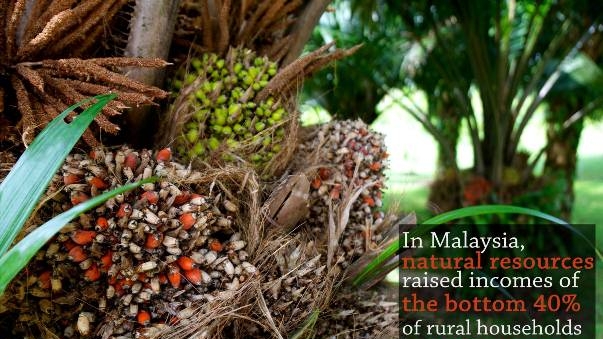- GDP is expected to grow by 5.1% for both 2013 and 2014, driven by higher consumer and business spending.
- As the global recovery gathers speed in 2014, Malaysia's external sector will increase its contribution to growth, offsetting the impact of tighter fiscal policies on the domestic economy.
- Malaysia’s recent economic performance and near term outlook owes much to the commodities sector, which includes crude oil, natural gas, rubber and palm oil.
- The sustainability of Malaysia’s favorable near-term outlook into 2015 and beyond hinges on the implementation of structural reforms.
- Malaysia is one of a few developing countries that successfully converted an abundance of natural resources into long-term sustainable growth. It was able to do this through the following:
- Sound policy choices ensured revenues from resource extraction were reinvested in the economy in the form of machines and buildings to generate sustained economic growth.
- Reinvesting natural resource revenues into productive non-oil assets, such as infrastructure and education, ensuring that future generations will benefit from resource wealth.
- The economy has been diversified horizontally, from commodities to non-commodities. Openness to foreign investment and labor helped promote the development of non-resource industries.
- Malaysia has also diversified vertically, from raw commodities to processed goods. From oil and gas, Malaysia moved on to building refineries and fertilizer plants.
- The diversification of the economy helped Malaysia avoid volatility from commodity price booms and busts. The exchange rate also remained competitive.
- Sound policy choices ensured revenues from resource extraction were reinvested in the economy in the form of machines and buildings to generate sustained economic growth.
- The economic growth harnessed from natural resources was shared among Malaysians, raising the average incomes of the bottom 40 percent of rural households by 7.1 percent a year on average over two decades, while poverty rates plummeted.
Challenges
- A global boom in commodity prices has brought new challenges.
- The economy has become less diversified, with high-tech manufacturing declining and commodities increasing as a share of exports.
- Unpredictable weather patterns- likely driven by climate change- have an impact on agricultural commodities.
- Fuel subsidies for transportation and gas subsidies for energy have led to higher carbon emissions and energy intensity in the economy.
Managing natural resources smartly and sustainably
Malaysia will need to ensure natural resources continue to be managed sustainably and smartly into the future. Policy-makers can consider measures such as:
- Improving sustainable consumption of natural resource rents by saving more of the resource revenues, possibly through Malaysia’s own natural resource fund.
- Reforming fuel subsidies and reviewing gas pricing and moving to targeted assistance that benefits the neediest.
- Diversifying the economy towards higher productive investments in non-commodity sectors.

